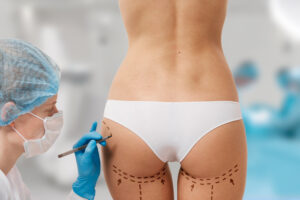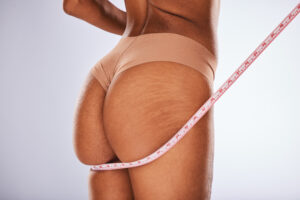Buttocks fat grafting — also called autologous fat transfer or “natural BBL” — is quickly becoming one of the most popular options for those who want fuller, shapelier curves without implants. By transferring your own fat from areas like the abdomen, thighs, or flanks into the buttocks, this procedure offers a natural way to enhance volume and contour while slimming down stubborn areas.
As more people look for safer, more subtle alternatives to traditional Brazilian Butt Lifts, curiosity about this procedure continues to grow. Below, Chungdam Jeunex Clinic answers the most frequently asked questions so you can decide if buttocks fat grafting is right for you.
What Exactly Is Buttocks Fat Grafting?
Buttocks fat grafting is a cosmetic procedure that removes unwanted fat from areas like the stomach, thighs, or back using meticulous manual liposuction. The fat is then purified and carefully injected into the buttocks to enhance shape and volume naturally. Unlike implants, this method uses your own fat, resulting in a smoother, more organic look — and you get the added benefit of contouring the donor area at the same time.
How Is This Different From a Brazilian Butt Lift (BBL)?
Although the terms are often used interchangeably, buttocks fat grafting typically refers to a more subtle, proportionate fat transfer. A traditional BBL may involve more aggressive fat harvesting for a dramatic lift and volume. Many patients today prefer a “natural BBL” approach that focuses on elegant enhancement rather than exaggerated curves — an aesthetic that aligns perfectly with Korean beauty ideals.

Who Is a Good Candidate?
The ideal candidate is in good health, has enough body fat to harvest, wants a natural and balanced silhouette, and prefers to avoid synthetic implants. Buttocks fat grafting works well for those who want subtle yet noticeable enhancement without large scars or foreign materials in the body.
What Is Recovery Like?
Most patients can expect about one to two weeks of downtime. It’s important to avoid sitting directly on the buttocks for at least two weeks and to wear compression garments for about four to six weeks. Swelling and bruising are normal for the first few weeks, with final results visible in three to six months. Sleeping on your stomach or side and using a special cushion when sitting can help protect the new fat cells.
How Much Fat Survives After Grafting?
Not all of the transferred fat stays permanently. On average, 60–80% of the fat survives long-term. To account for this, surgeons may slightly overfill the area. How much fat “sticks” depends on surgical technique, your body’s metabolism, post-op care, and overall health. Maintaining a stable weight helps preserve your results.
Is Buttocks Fat Grafting Safe?
When performed by an experienced, board-certified surgeon, buttocks fat grafting is generally safe and avoids risks associated with implants, such as rupture or capsular contracture. However, like any surgery, it does carry some risks, including rare but serious complications like fat embolism. That’s why choosing a reputable clinic and skilled medical team is essential for your safety and results.
Can I Combine It With Other Procedures?
Yes — many patients choose to combine fat grafting with other body contouring procedures for an overall harmonious look. Popular combinations include tummy tucks, breast augmentation or fat transfer, and additional liposuction. Doing multiple procedures at once can reduce overall recovery time and help achieve your desired silhouette in fewer visits.

How Long Do the Results Last?
Once the transferred fat establishes a blood supply, the results are typically long-lasting. Maintaining a healthy lifestyle helps ensure the results remain stable for many years. Some patients choose a touch-up procedure later if they want additional volume or refinement.
What Are the Risks or Side Effects?
As with any cosmetic surgery, some risks include partial fat reabsorption, asymmetry, infection, fat necrosis (small lumps or firmness), or rare complications like fat embolism. Choosing a trusted surgeon, following post-op instructions closely, and avoiding smoking or alcohol during recovery can help minimize risks.
How Much Does Buttocks Fat Grafting Cost in Korea?
Costs vary based on the surgeon’s experience, clinic reputation, and whether you’re combining procedures. At Chungdam Jeunex Clinic, buttocks fat grafting typically ranges from 4 to 8 million KRW (approximately USD $3,000–$6,000), including anesthesia, aftercare, and necessary garments.
Korea is renowned for providing premium cosmetic treatments with high standards and competitive pricing, attracting patients from around the world.
Example: Typical Fat Grafting Journey
| Step | What to Expect |
|---|---|
| Consultation | Meet with the Chief Medical Director to discuss your goals and check your suitability. |
| Surgery Day | Fat is harvested manually, purified, and grafted to the buttocks. |
| Recovery | Light activity encouraged; avoid pressure on the area. Full results appear in 3–6 months. |
| Aftercare | Compression garment use, follow-ups, and lifestyle guidance for lasting results. |
Final Thoughts: Is Buttocks Fat Grafting Right for You?
If you’re looking for a natural, elegant way to enhance your curves with minimal downtime and maximum precision, buttocks fat grafting at Chungdam Jeunex Clinic may be the solution for you. With over 20 years of experience, our Chief Medical Director delivers meticulous manual liposuction and advanced fat transfer techniques that prioritize your safety, comfort, and results.
Ready to reshape your silhouette naturally? Book your personalized consultation with Chungdam Jeunex Clinic today and discover what’s possible for you.

